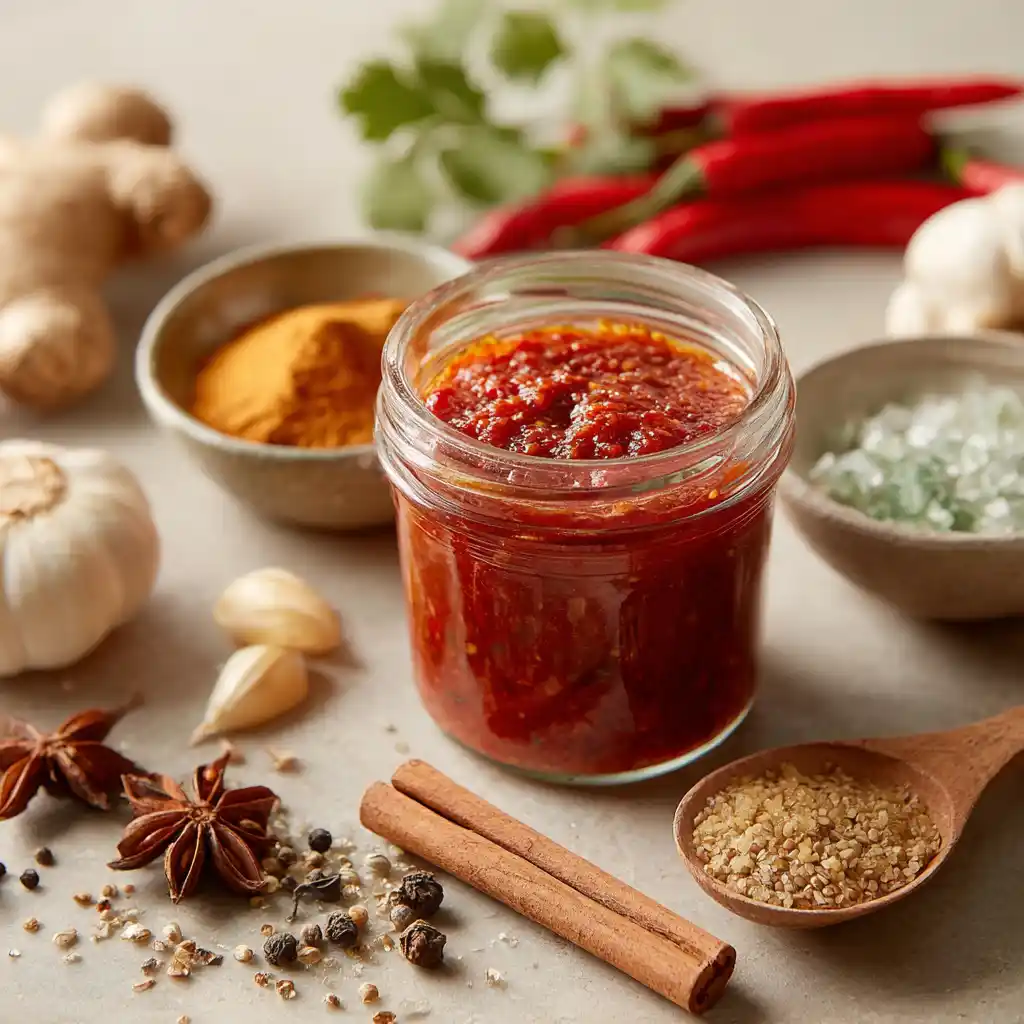The Story Behind My Harissa Paste (Keyword: harissa paste)
From Burnt Cornbread to Bold Harissa
I still remember the first time I tasted harissa paste. I was sitting at a café in Asheville where they served it alongside grilled lamb, and one fiery, smoky bite sent me straight back to the scents of my childhood kitchen in rural Virginia. My mama didn’t make harissa but she taught me to trust my nose and fingers in the spice cabinet. That fearless, feeling-first approach is exactly how I learned to make this punchy red paste from scratch.
As a self-taught cook, I’ve made my fair share of Southern staples, but harissa paste felt like discovering a flavor cousin from the other side of the world. It’s rich with roasted chilies, deepened by garlic, cumin, and caraway (more on that spice here), and mellowed with olive oil. I started grinding it in a mortar, mixing it into my collards, even blending it into a smoky mayo. One jar in the fridge quickly became a staple, replacing store-bought sauces with something bolder and homemade.
Table of contents
- The Story Behind My Harissa Paste (Keyword: harissa paste)
- Ingredients and Step-by-Step Method (Keyword Variation: make harissa paste)
- Using, Storing, and Pairing Harissa Paste (Keyword Variation: how to use harissa paste)
- Variations, Substitutions, (Keyword Variation: substitute for harissa paste)
- FAQs (Answering the Top 4)
- Conclusion
Why Make Harissa Paste at Home?
There are plenty of good jarred versions, sure. But homemade harissa paste is in a league of its own no preservatives, no filler oils, just dried chilies, toasted spices, and fresh garlic brought to life with good olive oil. You can control the heat level, make it chunky or smooth, and even add extras like smoked paprika or sun-dried tomatoes. Best of all, it takes less than 30 minutes and keeps in the fridge for weeks.
If you’re into making your own sauces, like this homemade habanero chili sauce, harissa paste should be next on your list. Whether you’re spooning it over roast vegetables or stirring it into a chickpea stew, it adds depth and warmth that bottled sauces can’t match.
We’ll cover the exact steps, ingredients, and tips below. But for now, know this: once you make your own harissa paste, you’ll never go back.
Print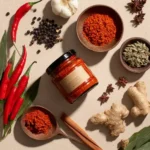
How To Make Authentic Harissa Paste At Home (Step-by-Step Recipe)
- Total Time: 20 minutes
- Yield: 1 cup 1x
- Diet: Vegan
Description
A bold and smoky North African chili paste made from dried chilies, garlic, and spices. Perfect for marinades, spreads, or stirring into soups.
Ingredients
6–8 dried guajillo or New Mexico chilies (stems and seeds removed)
3–4 garlic cloves
1 tsp caraway seeds
1 tsp cumin seeds
1 tsp coriander seeds
½ tsp salt
1 tbsp lemon juice
4–6 tbsp olive oil
Instructions
1. Soak the dried chilies in hot water for 20 minutes until soft. Drain and pat dry.
2. Toast the cumin, coriander, and caraway seeds in a dry skillet for 1–2 minutes until fragrant.
3. Grind the toasted spices to a fine powder using a mortar and pestle or spice grinder.
4. In a food processor, combine softened chilies, garlic, ground spices, lemon juice, and salt.
5. Blend while drizzling in olive oil until a thick, smooth paste forms.
6. Adjust texture with extra oil or a splash of water, if needed.
7. Store in a jar, topping with olive oil. Keep refrigerated for up to 3 weeks.
Notes
Use smoked paprika or a roasted red pepper for a smoky version.
Add tomato paste or sun-dried tomatoes for more depth.
Freeze in ice cube trays for quick use.
Great in sandwiches, soups, grilled meats, and eggs.
- Prep Time: 10 minutes
- Cook Time: 10 minutes
- Category: Condiment
- Method: Blended
- Cuisine: North African
Nutrition
- Serving Size: 1 tbsp
- Calories: 65
- Sugar: 0g
- Sodium: 120mg
- Fat: 7g
- Saturated Fat: 1g
- Unsaturated Fat: 5.5g
- Trans Fat: 0g
- Carbohydrates: 1g
- Fiber: 0.5g
- Protein: 0.3g
- Cholesterol: 0mg
Ingredients and Step-by-Step Method (Keyword Variation: make harissa paste)
What You’ll Need to Make Harissa Paste
Making harissa paste at home starts with the right ingredients and no, they’re not hard to find. The foundation is dried chilies. I usually go for guajillo or New Mexico chilies because they’re flavorful without being overly hot, but you can mix in a couple of arbols if you like the burn. You’ll also need fresh garlic, good-quality olive oil, and ground spices like cumin, coriander, and caraway seeds (a spice that’s essential to true North African harissa flavor).
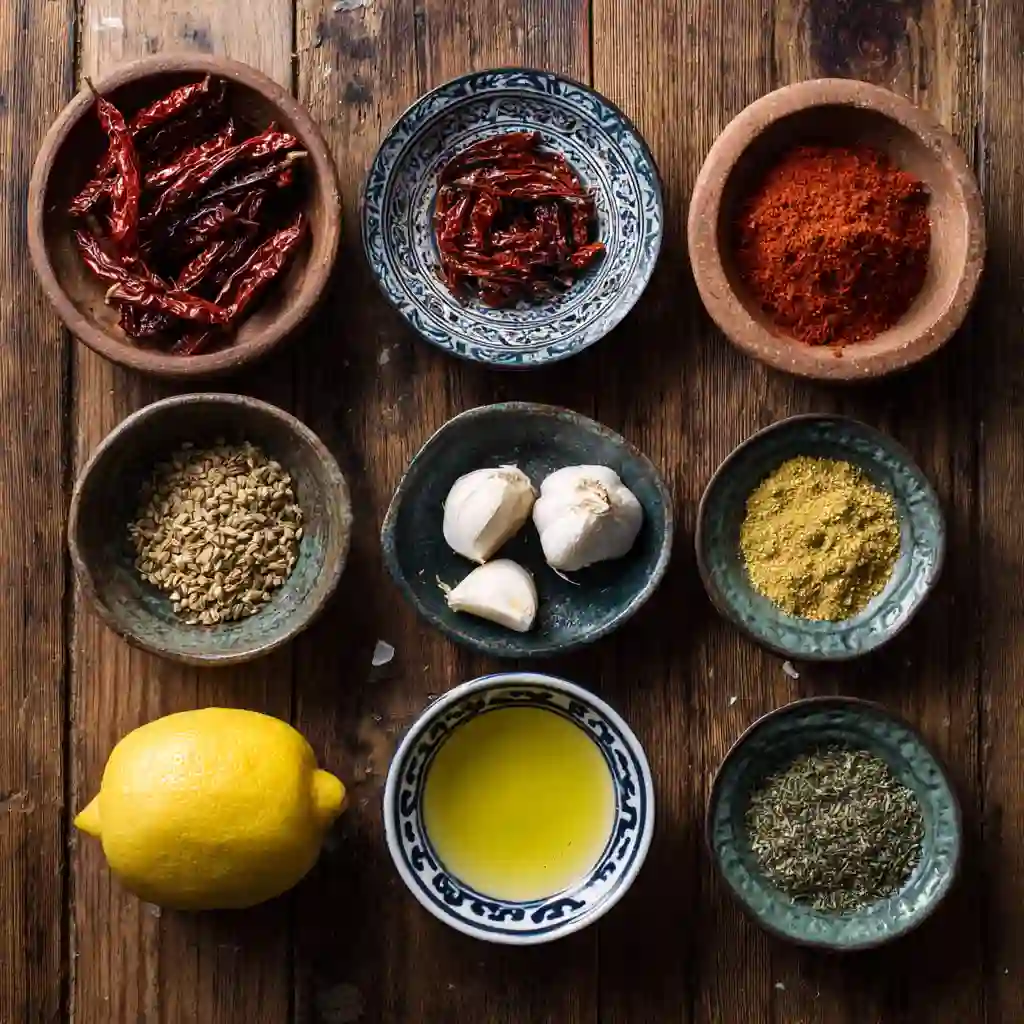
Here’s a simple, powerful lineup for flavor:
| Ingredient | Amount |
|---|---|
| Dried chilies (guajillo, pasilla, or New Mexico) | 6–8, stems and seeds removed |
| Garlic cloves | 3–4 |
| Caraway seeds | 1 tsp |
| Coriander seeds | 1 tsp |
| Cumin seeds | 1 tsp |
| Salt | ½ tsp |
| Lemon juice | 1 tbsp |
| Olive oil | 4–6 tbsp |
Toasting the spices is key don’t skip it. Just a minute or two in a dry pan will unlock their aroma. It’s a trick I also use when making easy bang bang sauce, where spices make or break the flavor.
Step-by-Step: How to Make Harissa Paste at Home
- Soak the chilies – Cover dried chilies in hot water for 20 minutes until softened. Drain and pat dry.
- Toast the spices – Lightly toast the cumin, coriander, and caraway seeds in a dry skillet for 1–2 minutes, until fragrant.
- Grind the spices – Use a mortar and pestle or spice grinder to make a fine powder.
- Blend the paste – In a food processor, combine softened chilies, garlic, ground spices, lemon juice, and salt. Blend while drizzling in olive oil until it becomes a thick paste.
- Adjust – Add more oil or a splash of water if needed. You can also stir in tomato paste or smoked paprika if you prefer a milder harissa.
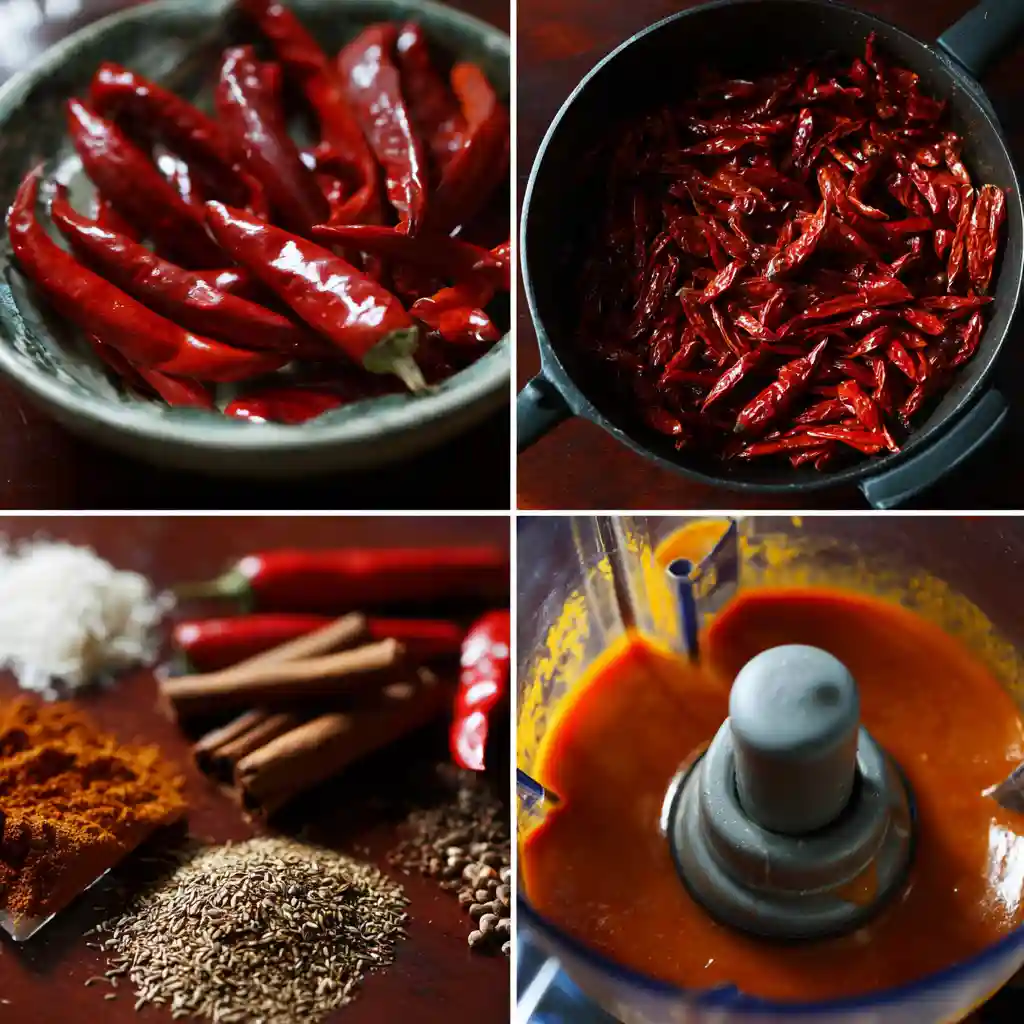
Store in a clean jar, topped with a layer of olive oil, for up to 3 weeks in the fridge.This paste works beautifully in North African classics like chicken couscous or even breakfast wraps inspired by traditional Arabic dishes.
Using, Storing, and Pairing Harissa Paste (Keyword Variation: how to use harissa paste)
Ways to Use Harissa Paste in Everyday Cooking
Once you make harissa paste, the hardest part is not putting it on everything. Seriously. This bold, smoky, garlicky blend turns even the plainest meal into something deeply satisfying. I often whisk a spoonful into yogurt or mayo for a fast dipping sauce. It works great as a marinade for chicken, especially when grilled, and it’s unbeatable stirred into soups, stews, and even eggs.
If you’re already making flavorful sauces like this Thai dipping sauce, you’ll love how harissa brings the same punch only with North African depth. Here’s a list of my favorite ways to use it:
- Rub onto chicken or lamb before roasting
- Mix into couscous or quinoa bowls
- Stir into lentil soup for smoky richness
- Blend with olive oil and drizzle over roasted veggies
- Use as a pizza sauce base for a spicy twist
- Mix with honey for a sweet-heat glaze
It even makes scrambled eggs taste like they came out of a restaurant kitchen. I sometimes use a swirl on toast, alongside sautéed spinach or leftover roasted veggies. Harissa paste is truly one of those sauces you start customizing to your own rhythm.
How to Store Harissa Paste (and Make It Last)
Because it’s packed with oil and acidic ingredients like lemon, harissa paste keeps well. I store mine in a clean glass jar with a layer of olive oil on top to help seal out air. In the fridge, it’ll stay good for 3 weeks or more.
If you plan to freeze it, portion it into ice cube trays. Pop out a cube whenever you need to spice up a quick weeknight meal just like I do when prepping a batch of spicy chickpeas or tossing together a fast salad. Speaking of salads, harissa mixed with olive oil and lemon makes a flavorful base for dressings (like in these from-scratch salad dressings).
Quick storage tips:
- Store in airtight glass jar
- Always top with olive oil after each use
- Refrigerate up to 3 weeks
- Freeze in small portions for up to 3 months
Harissa paste doesn’t just live in the fridge. It becomes part of your cooking flow. One spoon here, one smear there and suddenly your food feels alive.
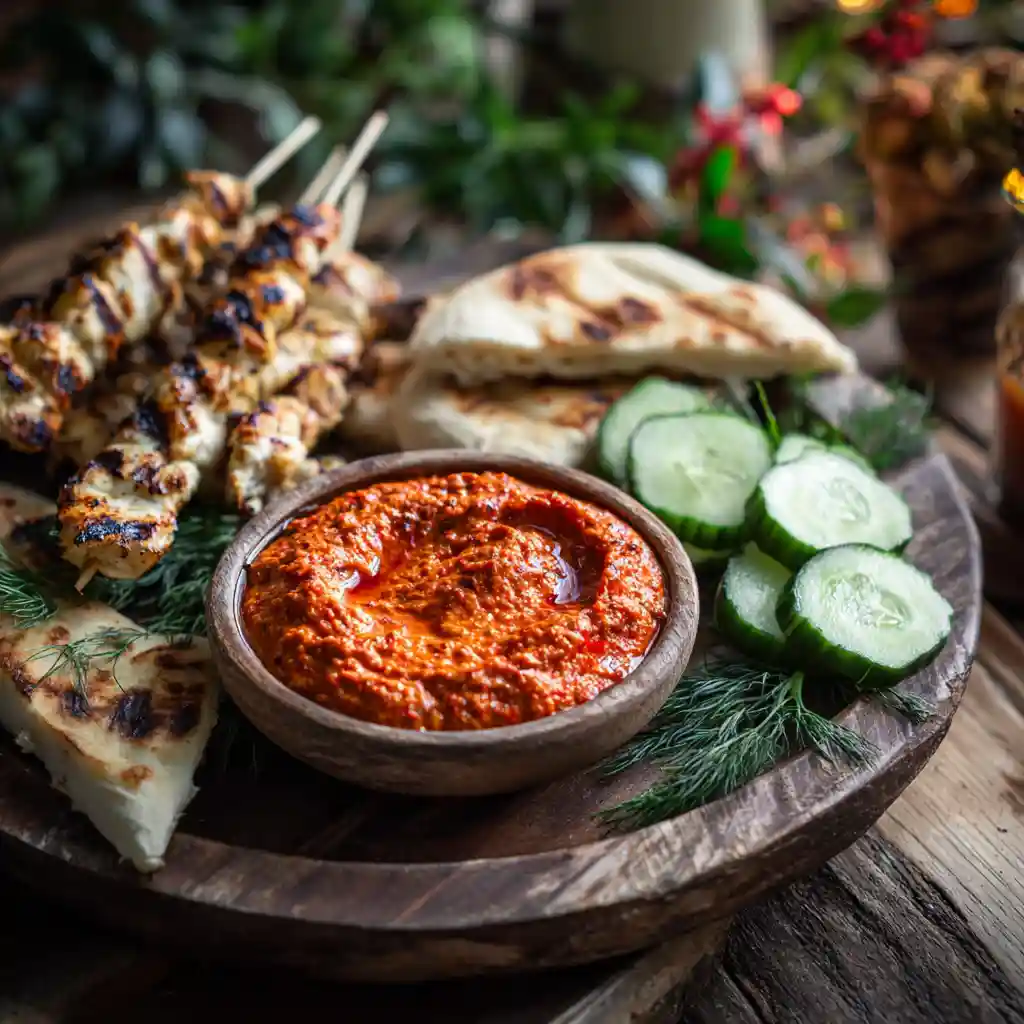
Variations, Substitutions, (Keyword Variation: substitute for harissa paste)
How to Customize Harissa Paste to Your Taste
One of the best parts of making harissa paste at home is tailoring it. Some folks want more garlic. Others want less heat. I say follow your senses just like my mama taught me.
If you’re not a fan of high heat, skip the spicy arbol chiles and stick with mellow guajillos. Want it smokier? Add smoked paprika or a roasted red pepper. Some people add tomato paste for sweetness or even sun-dried tomatoes for umami. A friend of mine stirs in a little honey when using it on grilled chicken, which I loved.
Here are simple tweaks depending on your needs:
| If you want… | Try this |
|---|---|
| Less heat | Use sweet or mild dried chilies only |
| More smoke | Add smoked paprika or chipotle peppers |
| Smoother texture | Add more olive oil while blending |
| Tangy balance | Increase lemon juice or add vinegar |
FAQs (Answering the Top 4)
Harissa paste is made from dried red chilies, garlic, olive oil, and spices like cumin, coriander, and caraway seeds. It may also include lemon juice, tomato paste, or smoked paprika depending on the variation.
A quick substitute includes mixing tomato paste with smoked paprika, cayenne, and garlic. You can also try sriracha blended with cumin and olive oil, but it won’t offer the same complexity as a true harissa paste.
It’s usually in the international aisle, near Moroccan or Middle Eastern ingredients. Some stores keep it with hot sauces or in the refrigerated section if it’s fresh.
Yes but the heat level varies. Traditional harissa is mildly to moderately spicy, but homemade versions allow you to control the heat by adjusting the chili types and quantities.
Conclusion
Making harissa paste at home is more than just a recipe it’s a ritual. The scent of toasted spices, the deep red blend of chilies and oil, and that bold flavor that lingers on your tongue it’s an experience worth repeating. Whether you’re dolloping it into couscous, brushing it over grilled meats, or using it as a secret ingredient in your next stew, it delivers every time. And once you’ve made it from scratch, you’ll feel the difference just like I did, right there in my Asheville kitchen, channeling my Southern roots into something global and full of fire.

